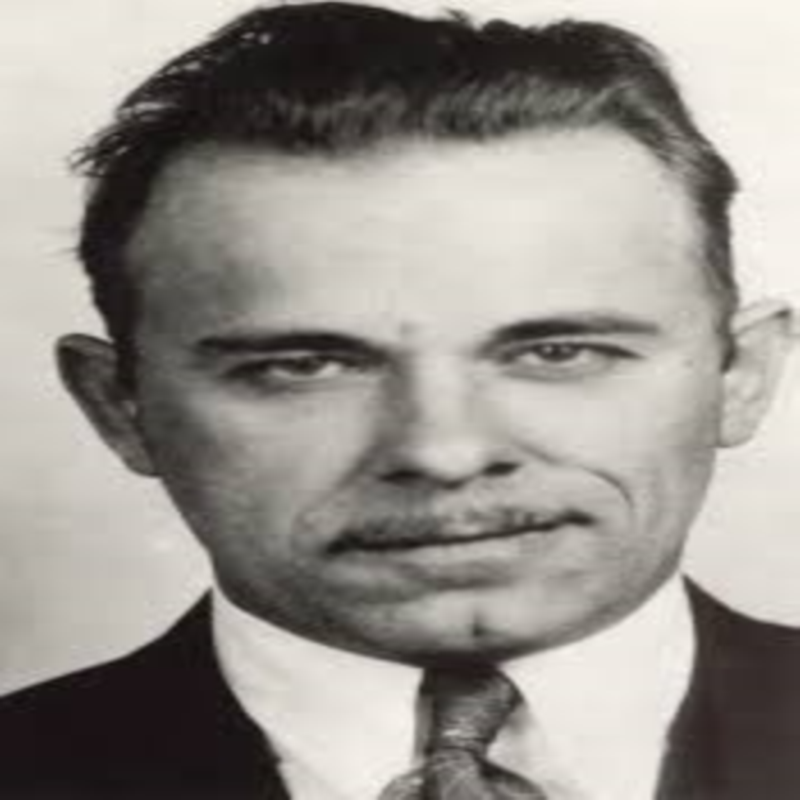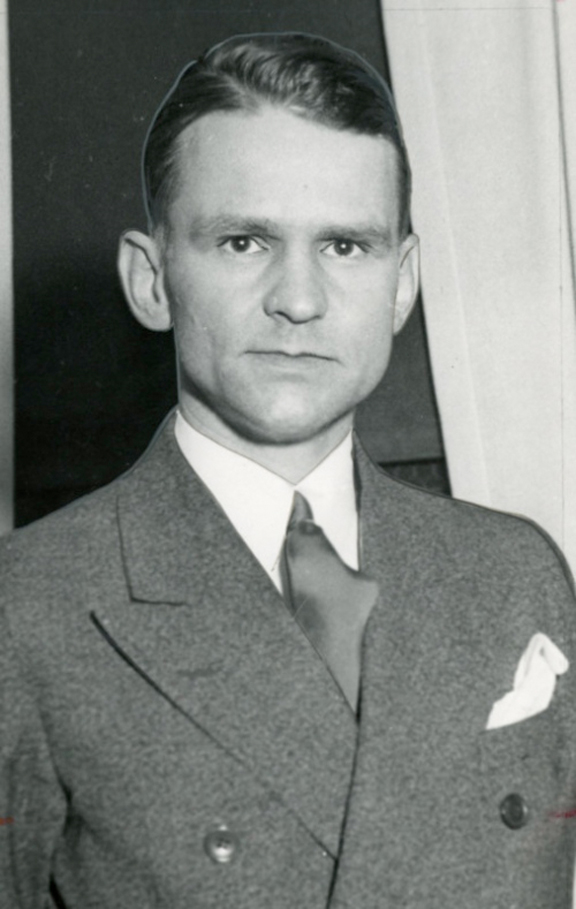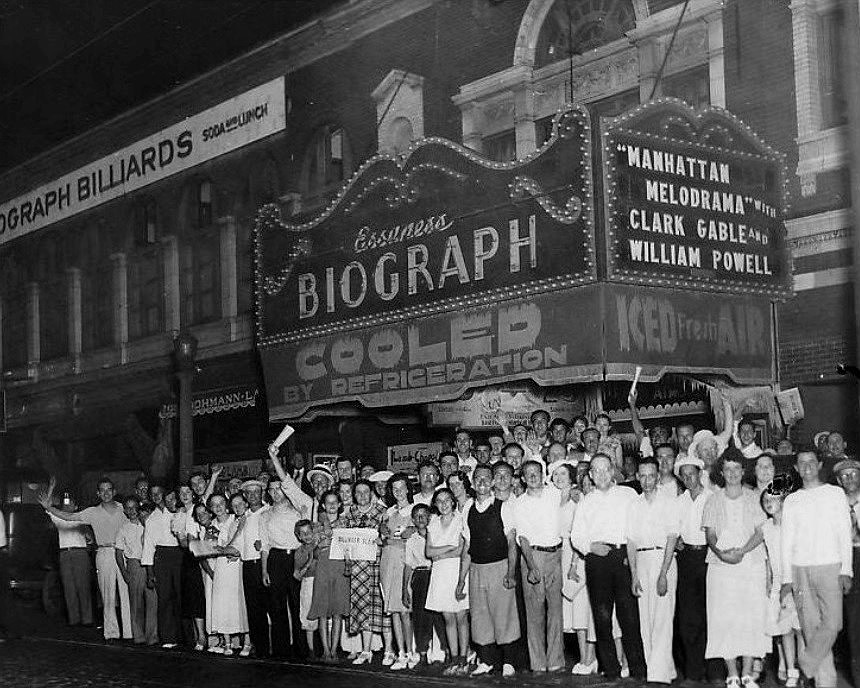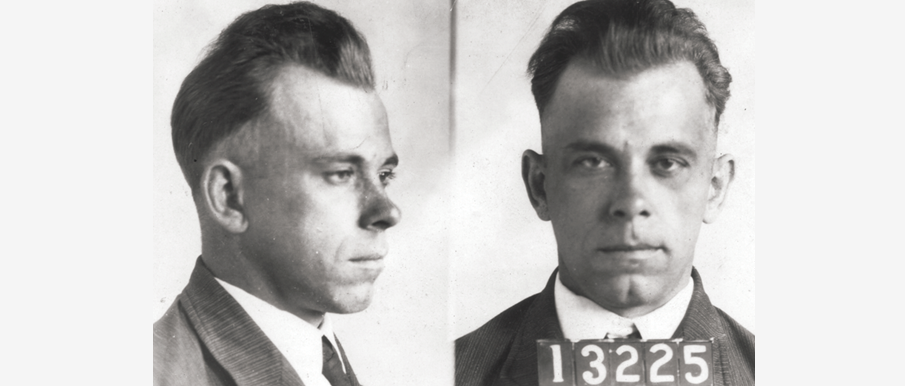John Dillinger: Public Enemy Number One
Posted on 16th September 2021
John Herbert Dillinger was born in Indianapolis on 22 June 1903, the son of a humble shopkeeper, who by the time he was killed thirty years later would be one of the most notorious men of his day and the first to be designated Public Enemy Number One; and though he robbed banks across the heartland of America he would die in that city most associated with gangsters – Chicago.
His mother died when he was still an infant and for a time, he was raised by his older sister Audrey but when his father, also named John, remarried he decided to raise his son himself and he proved a strict disciplinarian who rarely spared the rod. Such harsh treatment only seemed to bring the worst out of his son however’ and his reputation as a bully made him so unpopular with the parents of other children that his father decided to move them all to Mooresville in rural Indiana. If he believed that life in the city was corrupting his son and that a quieter life might see him change his ways, then he was to be sorely mistaken.
After leaving school Dillinger found work in a machine shop where he was acknowledged to be a hard but unreliable worker who more interested in partying and girls only ever turned up when it suited him.
In 1922, he was arrested for stealing a car and in an attempt to prevent a downward spiral into crime his father persuaded him to enlist in the United States Navy, but he deserted after just a few months. His relationship with his father now began to deteriorate and he was to express regret later in life how he had treated his father who he recognised had only tried to do his done his best in difficult circumstances.
Returning to Mooresville he met a local girl Beryl Hovious and after a whirlwind romance they married on 12 April 1924, and for a while at least he would often be heard to express his desire to live a respectable life but his attempts to hold down a regular job failed. Finally, along with a friend, Ed Singleton, he decided to rob a local store. They botched the job, roughing up the store owner and making off with only $50. As they fled the scene of the crime they were recognised by a local priest and promptly arrested.
Dillinger’s father now persuaded him to plead guilty in the hope of getting a lighter sentence but throwing himself on the mercy of the Court didn’t work and he was sentenced to between ten - and twenty-years imprisonment. His father never forgave himself for persuading his son to confess but Dillinger himself did – it wasn’t his fault, he said. He had merely wanted him to find gainful employment and make a success of his marriage. He and Beryl were in fact to divorce five years later.
Upon entering prison Dillinger had told his wardens: “I will be the meanest bastard you have ever seen when I get out of here.”
But he in fact took to prison life surprisingly well keeping out of trouble, toiling hard in the workshops, and he was in many respects a model prisoner, but he also got to know and learn from the most notorious inmates in the prison and by the time he was released eight years later he was also a model criminal.
He was paroled on 10 May 1933, following a petitioning campaign organised by his father and he was to repay his father’s efforts by forming his own criminal gang.
The Dillinger Gang’s first bank raid took place in the town of New Carlisle, Ohio, on 10 June 1933, when they escaped with $10,000. They soon after robbed further banks in Daleville and Montpelier, Indiana, stealing another $10,000. But Dillinger did little to cover his tracks and by the time he robbed the bank in Bluffton, Ohio, on 14 August, Law Enforcement were already on his trail.
On 6 September, he robbed the Massachusetts Avenue State Bank in Indianapolis but just two weeks later on 22 September he and his gang were arrested in Dayton, Ohio, and Dillinger was taken to Lima County Jail to await trial.
While under arrest he was questioned about a document found on his person that appeared to indicate he was planning a prison break. He denied all knowledge of its contents but just four days later eight of Dillinger’s friends escaped from Indiana State Prison with guns that had been smuggled into them killing two prison guards as they did so.
On 12 October, four of these escaped prisoners arrived at Lima County Jail claiming to be Police Officers who had orders to return Dillinger to Indiana State Prison for previous parole violations. When Sheriff Jess Sarber demanded to see their credentials, he was beaten and shot, dying a little later. Sarber was to be one of more than a dozen Law Enforcement Officers to be killed by the Dillinger Gang.
With Dillinger free once more the Gang now embarked upon an unprecedented series of bank robberies, and they were no longer robbing just small rural banks where the take was small. On 23 October 1933, they stole $74,000 from the Central National Bank and Trust Co. in Greencastle, Indiana; on 20 November, $28,000 from the American Bank and Trust Co. in Racine, Wisconsin; and on 15 January, 1934, $20,000 from the First National Bank in East Chicago, Indiana – and so it continued in Sioux Falls South Dakota, Mason City Iowa, and South Bend Indiana.
Following the bank robbery at Racine the gang holed up briefly in Chicago. There the police discovered that one of the cars that had been used in the robberies had been taken into a garage for servicing. They staked-out the garage. When gang member John “Red” Hamilton arrived to pick up the car he was approached by Officer William Shanley. Hamilton shot him dead and made his escape.
Shortly after, as the gang were leaving the scene of the robbery in East Chicago, they had been intercepted by seven police officers. In the ensuing fire fight Dillinger shot dead Officer William O’Malley.
In a further humiliation for the Authorities Dillinger had raided Police Arsenals at Auburn and Peru stealing machine guns, ammunition, and bullet-proof vests.
As far as Law Enforcement were concerned John Dillinger was a ruthless criminal who killed without compunction but in Depression-era America his flamboyant dress and showmanship was earning him the reputation of a hero similar to Robin Hood.
It isn’t unusual in times of great austerity and hardship for criminals opposing an unsympathetic Establishment to acquire heroic cult status and no one was better at playing to the gallery than, John Dillinger. He revelled in his new-found fame comparing himself to his hero the movie star Clark Gable who he believed he resembled.

As such, he never even attempted to disguise who he was instead announcing his name upon entering the bank before leaping over the counter and proceeding to charm the female tellers. He always considered himself a lady’s man even if most of his ladies were in fact prostitutes.
Sometimes he would fire a shot into the ceiling before politely requesting that all present lie down. He would then proceed to rob the bank but was always careful never to steal from the pockets of the customers present and it was as much his bravado as the crimes themselves that so outraged the Authorities.
By the middle of 1934, Dillinger’s crime spree and netted him and his gang in excess of $300,000, and though policemen had been killed he was never the most ruthless of criminals. He was always wary of injuring innocent bystanders, but he never shrank from defending himself against those who threatened his freedom.
Aware that the police were once more beginning to close in the gang decided to lie-low in Tucson, Arizona. The Congress Hotel where they were staying however caught fire and they were forced to flee in a hurry leaving their luggage behind. They then paid several the firemen present to retrieve their luggage for them, one of whom recognised who they were from the photos in the detective magazines he read. He went to the police, and over the next few days the gang, Peter Pierpont, Charles Makley, Ed Shouse, Charles Russell, and finally Dillinger himself were tracked down and arrested.
Dillinger was separated from the other gang members who were returned to Ohio to stand trial for the murder of Sheriff Sarber. Taken to the supposedly escape-proof jail at Crown Point but it wasn’t secure enough to hold John Dillinger who carving a fake wooden gun took the janitor hostage before forcing the guard to open his cell. The guard he then made to beckon his colleagues whom he took hostage one-by-one, locking them all in the cell before mocking them for being duped by a fake gun and making his escape in the local Sheriff’s new car.
By stealing the car and driving it across the State line his escape became a federal case and it fell under the jurisdiction of the Department of Investigation (the forerunner of the F.B.I) and its enthusiastic and ambitious young chief J Edgar Hoover.
Dillinger now headed for Chicago where he immediately set about forming a new gang, one of whom was to the notorious George “Baby Face” Nelson.
He was by now sharing a small room with his girlfriend Billie Frechette, but the constant comings-and-goings of the other gang members alerted his landlord who reported him to the police. The Department of Investigation immediately put the house under surveillance but when they decided to arrest one of the gang members as he left the house a gunfight broke out in which the gang member was killed and Dillinger wounded. Still, he managed to escape and returned to the family home in Mooresville, Indiana, to recuperate.
When he heard that his girlfriend Billie Frechette had been arrested and fearing she would crack under interrogation he wanted to shoot his way into the police station to rescue her but was told that to do so would almost certainly result in his death. As it transpired Billie did not reveal his whereabouts.
Dillinger and his gang reunited at the Little Bohemia Lodge in the small town of Manitowish Waters in Wisconsin. The owners were assured that if they did what they were told they would not be harmed. But despite the gang monitoring their movements they managed to slip away long enough to alert the Authorities.

A few days later the Lodge was surrounded by D.O.I agents under the charge of Melvin Purvis who was to bring more high-profile gangsters to justice than any other agent. On this occasion however he messed up.
The D.O.I agents were not in the mood to take chances and fired without warning on some people they thought were gang members. They turned out to be local residents who were unfortunately in the wrong place at the wrong time and three men were wounded, two of whom died later.
The gang now alerted to the agent’s presence came out firing and managed to make their escape with Baby Face Nelson killing an agent in the process but despite the gang’s initial escape the agents remained hot on their trail.
The following day Dillinger was again involved in a gunfight, this time in Hastings, Minnesota, that saw “Red” Hamilton, who had since re-joined the gang, killed. On 7 June, another gang member, Tommy Carroll, was killed in a shoot-out.
Law Enforcement was closing in and Dillinger realised that if he wanted to survive the gang had to go their separate ways. He returned to Chicago where he took an alias, got a job as a clerk, and regularly made fun of his likeness to the notorious John Dillinger. His spare time he spent in the company of a prostitute, Polly Hamilton.
In the meantime, J Edgar Hoover, following the humiliation at the Little Bohemia Lodge remained more determined than ever to track Dillinger down and he created a special task force dedicated to doing just that.
But it wasn’t to be rigorous police work that cornered John Dillinger rather that shadow which looms constantly over all criminals – betrayal.
Ana Cumpanas, also known as Anna Sage, was an illegal Rumanian refugee and prostitute who under the threat of deportation for being someone of low moral character said she would tell them all she knew of John Dillinger if they would look kindly upon her status.
She ran a brothel in Gary, Indiana, and knew Dillinger well, she said, and would be willing to participate in his capture if the threat to deport her was lifted. The Agency appeared to agree to her terms and so she told them that she was due to attend a movie showing at the Biograph Theatre in Chicago the next day 22 June 1934, along with Dillinger and Polly Hamilton.
The theatre would be surrounded, and she agreed to wear a bright red dress to make the party easily identifiable.
Melvin Purvis was again put in charge of the operation to apprehend Dillinger. He had the theatre surrounded, the roads leading to it blocked off and had all the exits covered. Meanwhile, Ana Cumpanas would wear a bright red dress to make herself and her party easily identifiable.
The decision was made to arrest Dillinger as he left the theatre to minimise the possibility of civilian casualties in any shoot-out. The order was also given that Dillinger should be shot dead at the first sign of any resistance. Purvis would light a cigar to indicate Dillinger’s exit from the theatre.

As the crowd tumbled from the theatre at the end of the nights entertainment and began to disperse Dillinger could be seen happily chatting to Ana and Polly oblivious of what was about to happen.
However, passing by Purvis he appeared to recognise him and stared for a moment. He glanced nervously down the street and began to distance himself from the two women. A few seconds later he began to run fumbling in his pocket for his gun as he did so. Almost immediately five shots rang out three of which ripped through his body, with one entering his head and exiting his face. It killed him instantly.
If Ana Cumpanas thought that her betrayal of Dillinger would allow her to remain in the United States, she was to be disappointed for she was deported just a few months later. But as much as she was disappointed J Edgar Hoover was delighted.
The death of John Dillinger, America’s most wanted criminal, was a great triumph for the Department of Investigation which had often been seen as nothing more than an ineffective force of relatively powerless bureaucrats. Hoover was to ensure that its success was widely trumpeted and the following year he was to preside over its reorganisation renaming it as the Federal Bureau of Investigation with himself as its first Director.
Doubt was cast at the time that the man killed at the Biograph Theatre was John Dillinger at all. Some witnesses said they recognised him and saw him escape, others who knew that the man killed, was too tall to be Dillinger. It was also suggested that the fingerprints taken from the corpse did not match his on file. But his father upon seeing Dillinger’s corpse in the morgue was said to have remarked – that’s not my boy.
Is it possible that the Agents present had killed the wrong man? To admit having done so would have been a huge embarrassment especially because they had already shot dead two innocent men dead from mistaken identity. Then again, such conspiracy theories are commonplace in considering the fate of those elevated to cult status.
John Dillinger was America’s first Most Wanted, its first Public Enemy Number One. Others were to follow including Baby Face Nelson, Pretty Boy Floyd, Machine Gun Kelly, Bonnie and Clyde and Al Capone but few were as colourful, and none were ever as popular as – John Herbert Dillinger.
Tagged as: Modern
Share this post:





